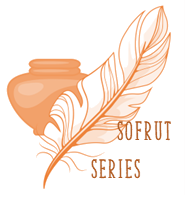
(לה) ׆ וַיְהִ֛י בִּנְסֹ֥עַ הָאָרֹ֖ן וַיֹּ֣אמֶר מֹשֶׁ֑ה קוּמָ֣ה ׀ יְהֹוָ֗ה וְיָפֻ֙צוּ֙ אֹֽיְבֶ֔יךָ וְיָנֻ֥סוּ מְשַׂנְאֶ֖יךָ מִפָּנֶֽיךָ׃ (לו) וּבְנֻחֹ֖ה יֹאמַ֑ר שׁוּבָ֣ה יְהֹוָ֔ה רִֽבְב֖וֹת אַלְפֵ֥י יִשְׂרָאֵֽל׃ ׆ {פ}
Advance, O יהוה !
May Your enemies be scattered,
And may Your foes flee before You! (36) And when it halted, he would say:
Return, O יהוה,
You who are Israel’s myriads of thousands!
The passage known as Sefer Binsoa in the rabbinic literature, in every extant Torah scroll, is offset in the sefer Torah by a pair (or very rarely a trio) of what appear to be inverted nuns.1
It has come to be accepted sofrut practice to write them as such, despite the scholarly view of Emanuel Tov that they are to be regarded not as letters (for adding letters to Torah would pasul it) but rather as brackets.
... actually these signs are misunderstood scribal signs for the removal of inappropriate segments, viz. the Greek letters... antisigma... and sigma.2
The passage is sometimes found written with the inverted nuns integrated into the text of the passage rather than isolates outside it. When this is done with two inverted nuns, they occur in Numbers 10:35 and Numbers 11:1. Very rarely, a third is added at the beginning of Numbers 10:36 as well.
(לה) וַיְהִ֛י בִּ׆סֹ֥עַ הָאָרֹ֖ן וַיֹּ֣אמֶר מֹשֶׁ֑ה קוּמָ֣ה ׀ יְהֹוָ֗ה וְיָפֻ֙צוּ֙ אֹֽיְבֶ֔יךָ וְיָנֻ֥סוּ מְשַׂנְאֶ֖יךָ מִפָּנֶֽיךָ׃ (לו) וּבְ׆חֹ֖ה יֹאמַ֑ר שׁוּבָ֣ה יְהֹוָ֔ה רִֽבְב֖וֹת אַלְפֵ֥י יִשְׂרָאֵֽל׃ ׆ {פ}
(א) וַיְהִ֤י הָעָם֙ כְּמִתְאֹ֣׆נִ֔ים רַ֖ע בְּאׇזְנֵ֣י יְהֹוָ֑ה וַיִּשְׁמַ֤ע יְהֹוָה֙ וַיִּ֣חַר אַפּ֔וֹ וַתִּבְעַר־בָּם֙ אֵ֣שׁ יְהֹוָ֔ה וַתֹּ֖אכַל בִּקְצֵ֥ה הַֽמַּחֲנֶֽה׃
Advance, O יהוה !
May Your enemies be scattered,
And may Your foes flee before You! (36) And when it halted, he would say:
Return, O יהוה,
You who are Israel’s myriads of thousands! (1) The people took to complaining bitterly before יהוה. יהוה heard and was incensed: a fire of יהוה broke out against them, ravaging the outskirts of the camp.

The Baal haTurim (13th-14th c CE) opined that the reason this is marked with the nun hafucha (inverted nun) is on account of the numerical value of the letter nun being fifty and the textual position of this passage being fifty pasukim (verses) removed from its proper place. It is drawn backwards to point back in the direction of the passage's appropriate placement.3
Rashi was of the same opinion as well:
A similar exegesis was applied to the verse (Zechariah 4:14), “These are the two sons of the pure oil, who serve the Master of all the Earth.” These are Aaron and the Messiah. I would not be able to tell which of them was the more beloved, except that it says [with regard to the Messiah], “The Eternal has sworn and will not change His mind; you will be a priest forever, [the rightful king that I have chosen]” (Psalms 110:4). From this verse we know that the messianic king is even more beloved than a rightful priest.
See, it says (Psalms 80:14), “A wild boar from the forest [hazir miya’ar] will gnaw at it.” Shouldn’t it say: A hippopotamus from the river [hazir miye’or] will gnaw at it? But it says “from the forest,” because when Israel does not do the will of God, then the gentiles will come upon them like a wild boar from the forest. Just as a wild boar from the forest will kill people and injure other animals, and is a torment to people, so whenever Israel does not do the will of God, the gentiles will come and kill them, torture them, and injure them. But when Israel does the will of God, the gentiles do not rule over them, and are like a hippopotamus from the river. Just as a hippopotamus does not kill people, and causes no injury to other creatures, so whenever Israel does the will of God, no foreign nation will kill, injure, or torture them. And then it will be written as: From the river [i.e., miye’or, with an aleph, instead of miya’ar, with an ayin].
Naftali Zvi Yehuda Berlin (1816-1893), also known as the Netziv, was the author of a commentary which has become a modern classic. The Netziv led the famed Volozhin Yeshiva for almost forty years. His first wife was the daughter of R Yitzchok Volozhin, son of R Chaim Volozhin, regarded as the spiritual successor to the Vilna Gaon, according to whose suggestion the yeshiva had been founded.
Rabbi Menachem Mendel Kasher observed a variety of different shapes for these inverted nuns, which he illustrated in his important work Torah Sh'leimah.4 Examples 17 and 18 below are horizontally-inverted nuns; 19 and 21-23 (zed-shaped) invert only the foot; and 20 (S-shaped) inverts only the head. Vertical inversions are also attested.

Rabbi Solomon Luria observed no fewer than twelve different arrangements of the inverted nun pair,5 and there are many more in extant Torah manuscripts which escaped his observations.6
Notes and References
- C. D. Ginsburg, Introduction to the Masoretico-Critical Edition of the Hebrew Bible (New York, N.Y.: Ktav, 1966; orig. 1897)), 341-5.
- Emanuel Tov, Textual Criticism of the Hebrew Bible (3rd ed.; Minneapolis: Fortress Press, 2012), 51.
- Ya'akov ben Asher, Tur on Torah (early 14th century).
- Menachem Mendel Kasher, Torah Sh'leimah (vol. 29; Jerusalem: American Bible Encyclopedia Society, 1978).
- Solomon Luria, שו''ת רש''ל (Fürth: Hirsch, 1768), §73.
- Sid Z. Leiman, "The Inverted Nuns at Numbers 10:35-36 and the Book of Eldad and Medad," Journal of Biblical Literature (1974) 93 (3): 350 (348–355).




